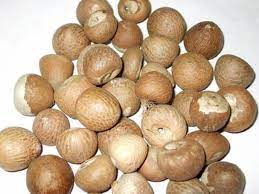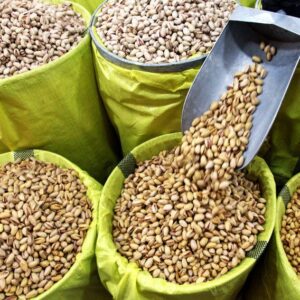Betel nut chewing, also called betel quid chewing or areca nut chewing, is a practice in which areca nuts (also called “betel nuts”) are chewed together with slaked lime and betel leaves for their stimulant and narcotic effects. The practice is widespread in Southeast Asia, Micronesia, Island Melanesia, and South Asia. It is also found among the indigenous peoples of Taiwan, Madagascar, and parts of southern China. It has also been introduced to the Caribbean in colonial times.
The preparation combining the areca nut, slaked lime, and betel leaves is known as a betel quid (also called paan or pan in South Asia). It can sometimes include other substances for flavoring and to freshen the breath, like coconut, dates, sugar, menthol, saffron, cloves, aniseed, cardamom, and many others. The areca nut itself can be replaced with or chewed with tobacco, and the betel leaves can be excluded altogether. The preparation is not swallowed, but is spat out afterwards. It results in permanent red stains on the teeth after prolonged use. The spit from chewing betel nuts, which also results in red stains, is also often regarded as unhygienic and an eyesore in public facilities in certain countries.
The practice of betel nut chewing originates from Island Southeast Asia where the plant ingredients are native. The oldest evidence of betel nut chewing is found in a burial pit in the Duyong Cave site of the Philippines (where areca palms were originally native to), dated to around 4,630±250 BP. Its diffusion is closely tied to the Neolithic expansion of the Austronesian peoples. It was spread to the Indo-Pacific during prehistoric times, reaching Micronesia at 3,500 to 3,000 BP, Near Oceania at 3,400 to 3,000 BP; South India and Sri Lanka by 3,500 BP; Mainland Southeast Asia by 3,000 to 2,500 BP; Northern India by 1500 BP; and Madagascar by 600 BP. From India, it was also spread westwards to Persia and the Mediterranean. It was also previously present in the Lapita culture, based on archaeological remains dated from 3,600 to 2,500 BP, but it was not carried into Polynesia.
Betel nut chewing is addictive and has been linked with adverse health effects (mainly oral and esophageal cancers), both with and without tobacco. Attempts to control betel nut chewing by the World Health Organization remains problematic as it is deeply rooted in many cultures, including possessing religious connotations in some parts of Southeast Asia and India. It is estimated that around 600 million people practice betel nut chewing worldwide.











